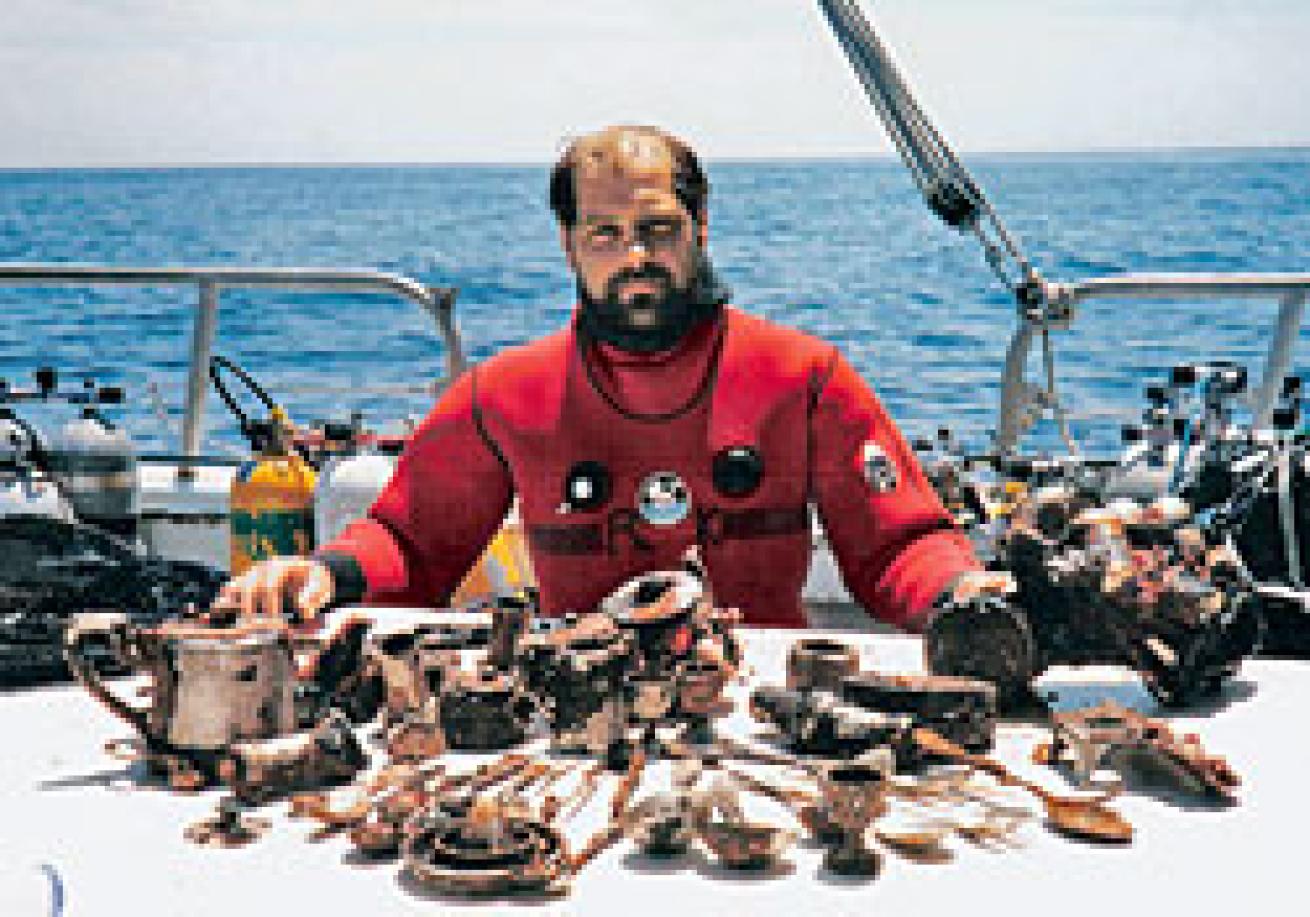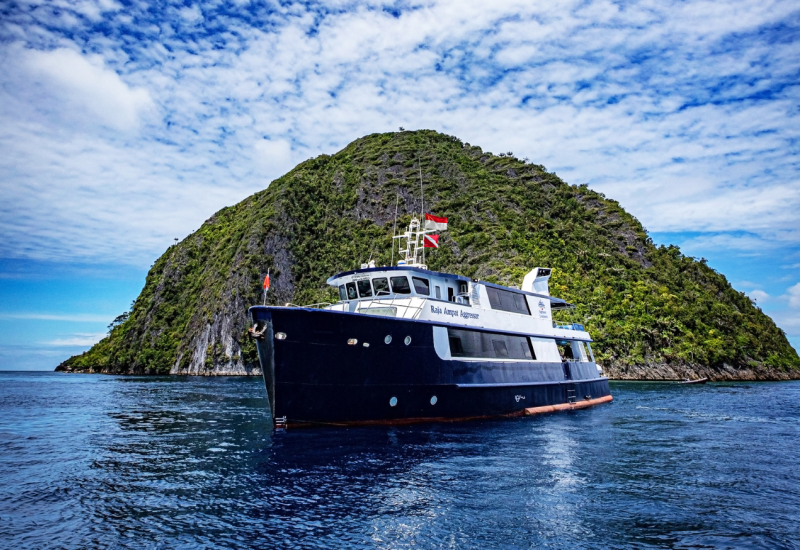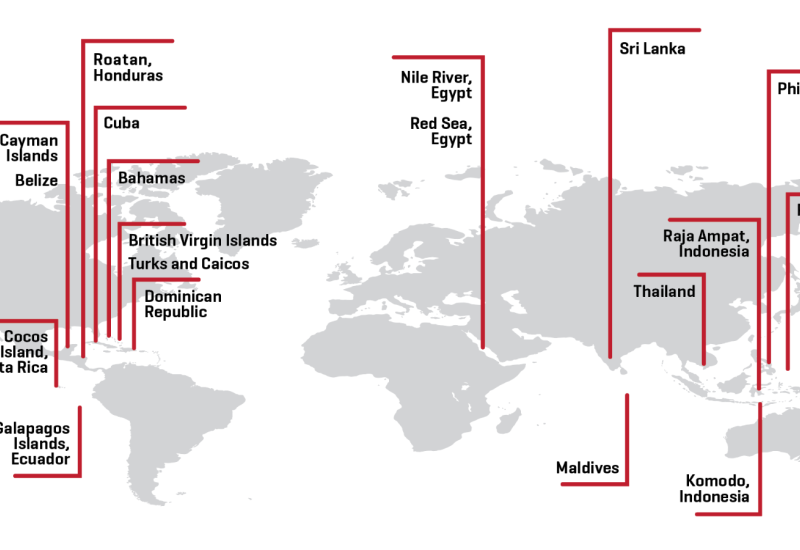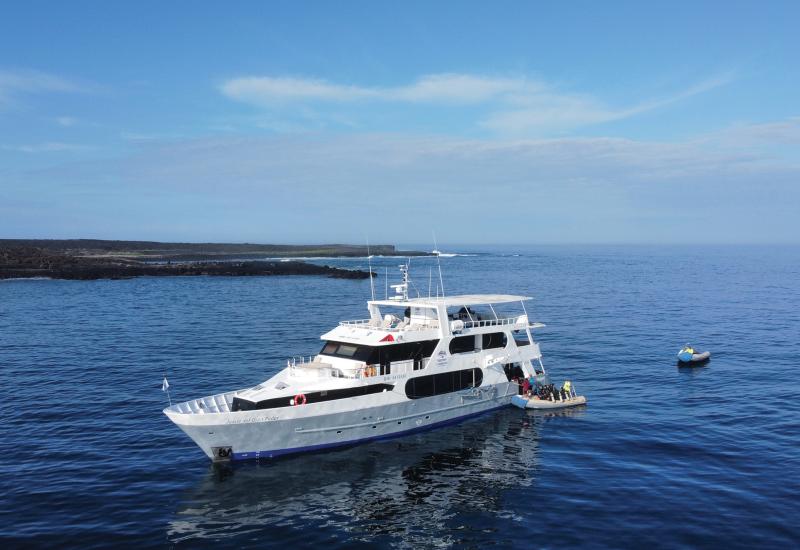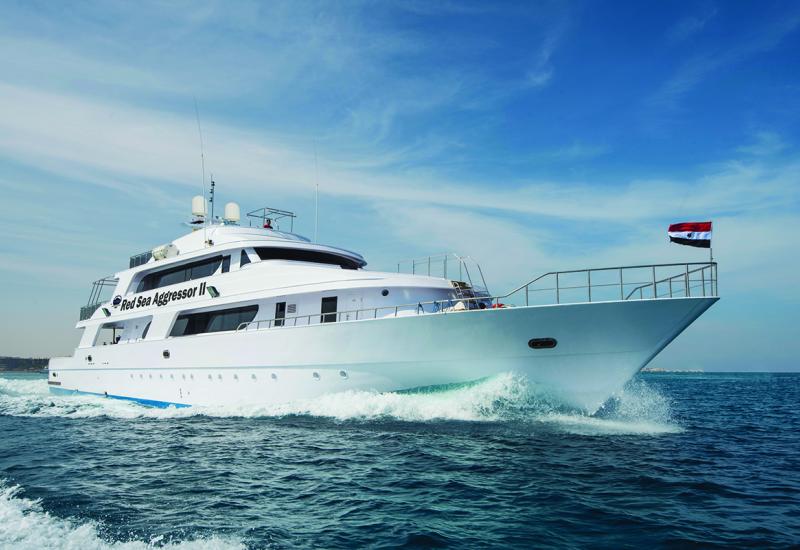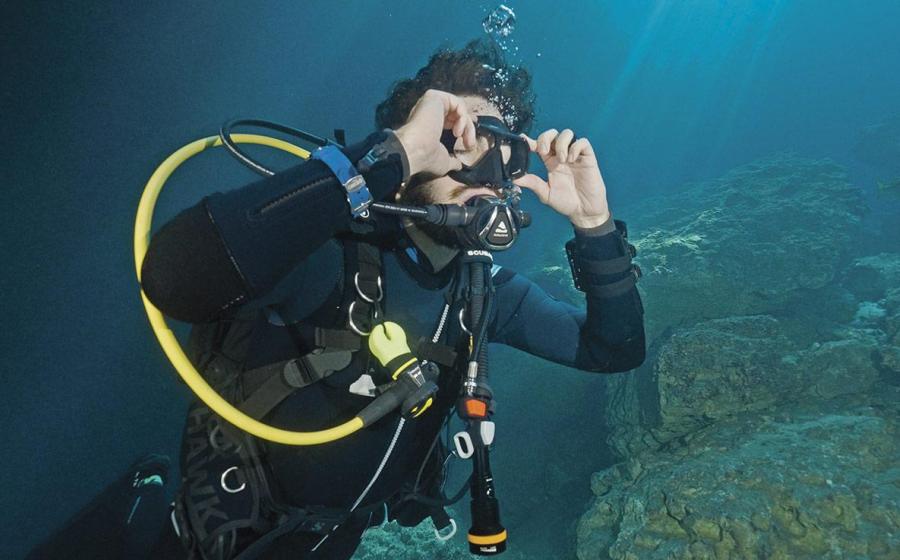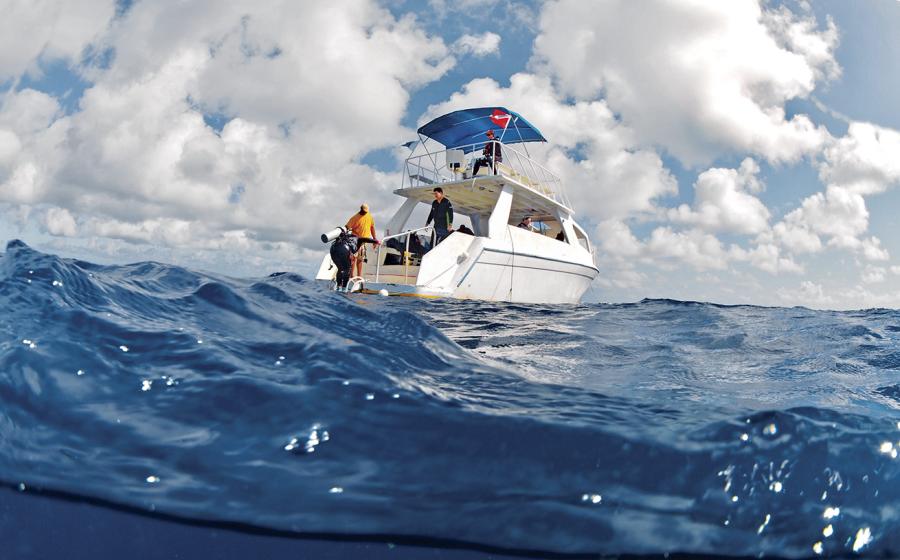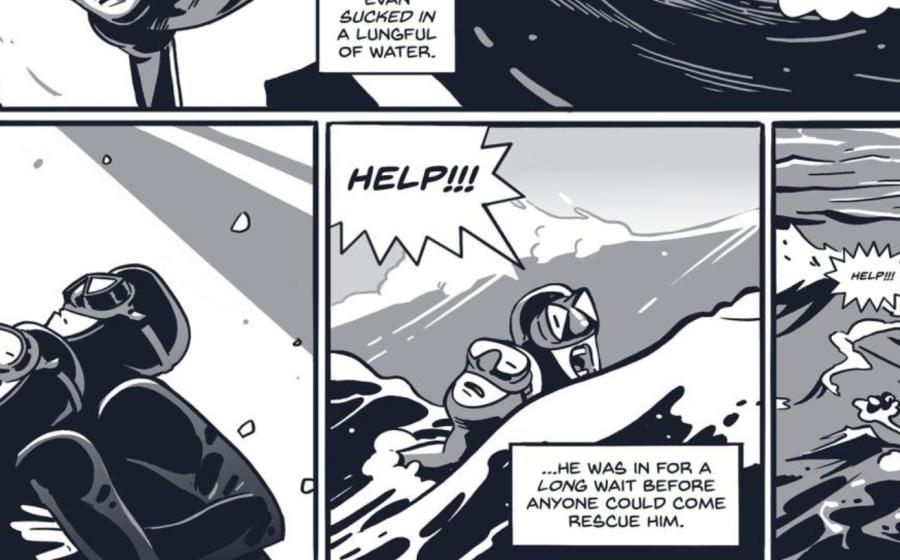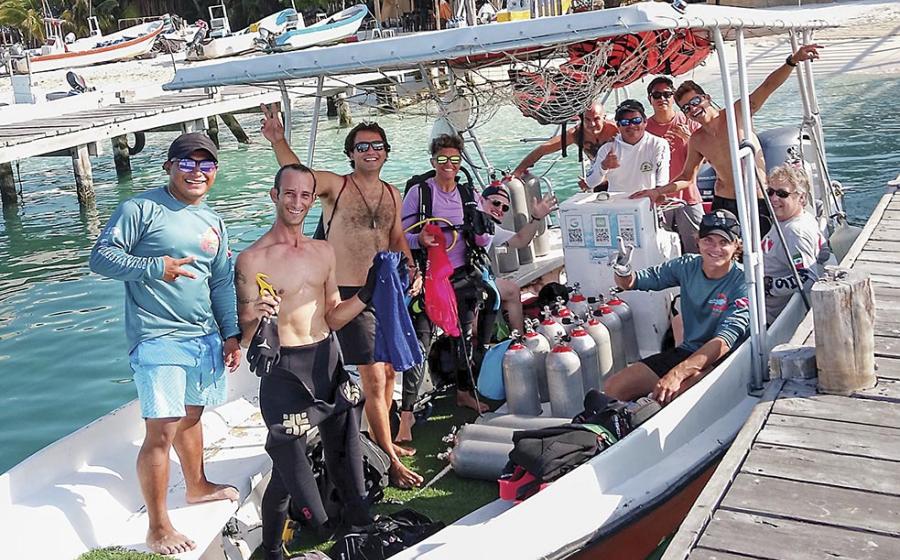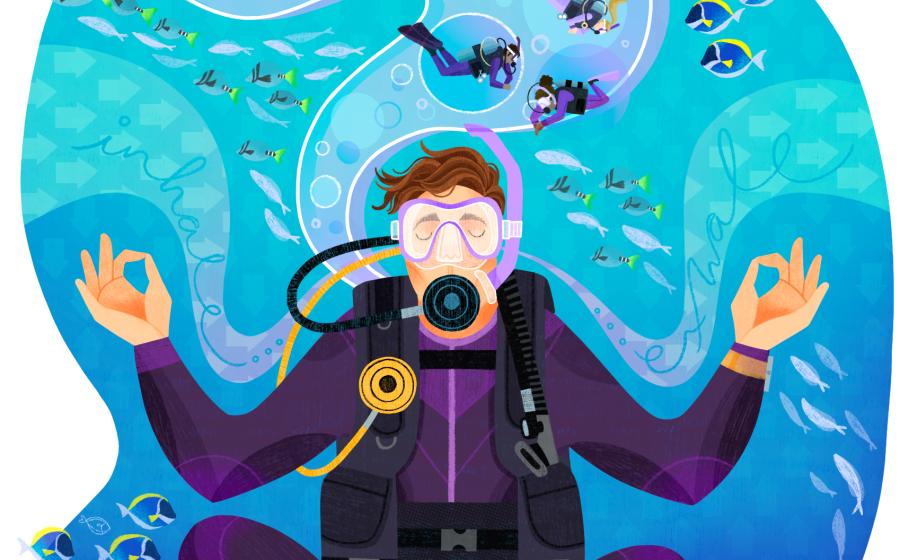The Legendary Andrea Doria

April 2007
REMEMBERING THE DORIA
Nothing Quite Like the Doria
By Bob Sterner
This summer, as they have for nearly every season over the past five decades, a new generation of men and women will brave rough seas for the 100-mile ride to the wreck of the Andrea Doria. They will test themselves, their gear and their training in the kind of adverse conditions most recreational divers fear-dark, bone-chilling water, unpredictable ocean currents and depths reaching 250 feet. If they are successful, they will proudly add "the Mount Everest of wreck diving" to their logbooks. And if they aren't, they may join the roster of divers (14 as of early 2007) who have died in the pursuit.
There are deeper wrecks, like the Lusitania at 320 feet, and the Britannic at 395 feet. There are more historic wrecks, like the USS Saratoga sunk during nuclear tests at Bikini Atoll. And there are certainly more inviting wrecks the world over. But there is no wreck that captures the imagination quite like the Doria.
The dive that once defined deep ocean wreck diving-and inspired men and women to rewrite the rules of the sport so they could safely explore her-will mark the start of her 51st year in the bottom of the Atlantic this summer. Now in a state of accelerating collapse, the Doria's glory days may be over, but divers still come to challenge themselves on a shipwreck that was a legend even before she sank.
The whole world knew of the Andrea Doria, flagship of the Italia Line, long before the 697-foot passenger liner made her maiden voyage in 1953. In the aftermath of World War II, Italy was reclaiming its reputation as the world's nexus of culture and beauty, and the Doria, named for a 16th-century Italian admiral who figured out how to sail ships against the wind, lacked no refinement. It took a full year to fill the interior with the works of Italy's leading artists, and the ship boasted four different sets of ornate china, crystal and silverware-one for each of her three passenger classes and one for the crew. Media around the world tracked the construction and launch of the vessel almost like paparazzi track Jennifer Lopez today.
The Doria's demise three years later also made global headlines. In pea-soup fog, the Doria and the Stockholm, another passenger liner outbound from New York, collided south of Nantucket, Mass. Half of the Doria's lifeboats were rendered useless in the crash, but passengers were blessed with an 11-hour sinking and the biggest rescue effort in maritime history. The 51 who perished — 46 on the Doria and five on the Stockholm — died in the collision. In all, 1,660 passengers and crew were rescued before the ship sank on the morning of July, 26, 1956, ultimately coming to rest on her starboard side.
The following day, New York department store heir Peter Gimbel and Joseph Fox became the first people to dive the Doria. Gimbel photographed the wreck for Life magazine and later led commercial salvage missions to retrieve her safe and other valuables. But it was Michael de Camp, the father of Northeast wreck diving, who led the way for purely recreational divers. In 1966 he rounded up a dozen friends who chipped in $50 a head to get to the Doria aboard a chartered fishing boat.
"We got to the wreck at sunset, so the first dive on it was a night dive," de Camp recalls. "Going down the line, I kept going deeper and deeper and thought I probably wasn't going to come back up. But then the wreck appeared in our lights. It was beautiful. Anemones were starting to grow on its hull and fish were everywhere. We stayed about 15 minutes and then headed up." Gear in those days consisted of steel 72-cubic-foot tanks, over-pressurized and yoked together for maximum volume. There were no depth gauges or tank pressure gauges then, and bottom times were tracked by sealing a watch in a plastic case. If it flooded, the increasingly harder draw on your unbalanced double-hose regulator gave a physical cue it was time to head toward the surface. Extreme narcosis was a given on every dive, and for thermal protection in 48-degree water, divers shivered in quarter-inch wetsuits. In a January 1969 cover story in Skin Diver magazine, cinematographer Al Giddings was the first to compare the Doria to Mount Everest. He was referring to the difficulty of filming the wreck-the dense silt particles blowing everywhere reminded him of a Himalayan peak in a howling snowstorm — but the description stuck because it also summed up the extreme physical challenge of diving the wreck.
The heyday of Doria diving began in the 1980s. Improved gear made it possible for divers to stay on the wreck longer, and there was the new challenge of penetrating the wreck's interior. During their 1981 expedition, Gimbel and his crew cut an opening into the first-class section of the ship and now recreational divers were using it to prowl below decks and bring back souvenirs. Abundant and portable, the ship's ornate china and silver were favorites and soon became badges of wreck-diving honor. There were even regular charters to the wreck, but they were by invitation only as the Doria was still very much outside the bounds of normal recreational diving. In response to the wreck's rising death toll, the men and women who explored the wreck scoured deck plans to make their penetrations safer. They embraced advances in gear and experimented with any technique that could lengthen their bottom times. "Doria diving became more cerebral," explains Dan Crowell, former captain of the Seeker, a popular ride to the wreck.
Wreck explorer John Chatterton credits the willingness of Doria divers to take risks and experiment with decompression procedures, nitrox and mixed gases, with bringing technical diving into the mainstream. Until the 1990s, "there were no standards," Chatterton says. "We'd bastardize the Navy tables and compute our own decompression stops. We weren't promoting anything; we just wanted to explore. The cooler heads in the dive industry knew where we were going, and did a great service by developing standards and training. All of this came about from the Andrea Doria."
Diving the Doria is still a physical challenge, but divers no longer have to gut out extreme narcosis or push the limits of oxygen toxicity on the wreck. Today, mixed gas diving on either open-circuit scuba or rebreathers is both the norm and a necessity as the wreck has begun to flatten out on the sand. "It's collapsed quite a bit," Crowell says. "Divers used to look over deck plans to see where they wanted to go, and getting there was almost like following the blueprint. Now, it's like someone took all of those prints and crinkled them up."
Photographer Brad Sheard was amazed at the wreck's disintegration when he visited it last summer for the first time in 10 years. "What we dove on was almost a pile of rubble it was so flat. It was disappointing. One of the most alluring things about the Doria was it being this big intact ocean liner lying on its side. You could swim along the wreck and go past the three swimming pools one after another with all of their diving boards still in place. Now there are staircases that had been inside, out lying in the sand. You can't swim down through the wreck to the first-class bar and look for china. For me, the magic is gone." Taking souvenirs has always been a big draw of the Doria. China, crystal, silverware, silver trays, drink markers, shuffleboard pucks and other trinkets all emblazoned with the Italia Line logo are among the cherished mementos of elite wreck divers. Although the interior cubbyholes where these items were stored may now be buried under rubble, there are still artifacts to be found, and the collapse of the wreck is adding urgency to recovering them.
John Moyer obtained salvage rights to the Doria in 1992 just before wresting two 1,000-pound ceramic panels from the ship's Winter Garden Lounge. The six- by five-foot artworks were created by Guido Gambone, a Picasso contemporary, and along with a bronze statue of Admiral Doria, are the centerpiece of Moyer's traveling museum show on the wreck. When he returned two years later, the lounge had collapsed to the seafloor.
Despite his stake, Moyer encourages divers to take small artifacts like china and silverware if they find them. "The thrill that is the Doria is that it is an important part of maritime history," he says. "The wreck is falling apart, like all wrecks do. It's important that things get recovered, properly restored and displayed in public to keep alive the legend of the Andrea Doria."
The Air of Everest
By John Chatterton
It was called "the Mount Everest of wreck diving," and in many ways it really was. Before rebreathers and before trimix, air-breathing wreck divers were testing themselves and their equipment on the wreck of the Andrea Doria. In retrospect, I consider myself lucky to have been there in the 1980s. I was in the right place at the right time.
Long before I made my way to the wreck, it had been explored by virtually all of the sport's wreck-diving legends like Peter Gimbel, John Dudas, George Hoffman, Mike de Camp and Bill Nagle, yet they barely scratched the surface of the wreck's potential.
Nagle was the captain of the dive boat, Seeker, my usual ride. He was an experienced Doria diver and my wreck-diving mentor. Before I made my first dive to the wreck, Bill warned me that the Doria was very dangerous. I clearly understood that any wreck in 250 feet of water was indeed a dangerous place for a diver, but that was not what he meant. "The Doria is dangerous because it is so highly addictive," he said. "You'll see. You'll have to keep coming back."
I thought Bill was crazy. I knew how much preparation, dedication and money it took just to get there. I was not going to make 100 dives on the Doria. I was going on a single trip, it was going to be the highlight of my diving career, and then I was moving on, or so I thought. Ultimately, Bill was right. I would make more than 150 Doria dives before the new millennium.
The Doria lies on her starboard side in about 250 feet of water. Back in the 1980s the port side was only about 180 feet deep. On the right day, any open-water diver could swim down and touch the Doria. The problem is that you can't tell from the boat if it is the right day. Oftentimes the ocean surface will be completely still, but current can be roaring on the wreck. Visibility can be 100-plus feet, but it is more likely to be 10 to 20 feet. One thing is for sure: It's always cold, roughly 38 to 48 degrees.
Until computers came along, we had to use the U.S. Navy dive tables. Unfortunately, there were no repetitive tables for air dives over 190 feet. We were not going to stay above 190, or sacrifice our repetitive dives. We overcame this obstacle by interpolating the Navy tables in a way I should probably not describe. It was not exactly what we learned in open-water training.
In the 1980s, deep diving was not acceptable to the mainstream. It was outlaw diving and we were bad boys (and girls). Of those who crossed the 130-foot redline, there were divers who were content simply to make it to the wreck and satisfied to touch the exterior. But what made the Doria the Doria was found inside. Its uniqueness was defined by the almost limitless penetrations it offered. Completely unexplored areas of the wreck awaited those willing to enter. This is what made the Doria different from all the other wrecks of the day. It gave you plenty of rope to hang yourself.
Like most of my peers, I became bolder with every dive. Eventually, I could swim solo down to the wreck, drop into the promenade, swim down to the double doors, enter into the wreck on the promenade deck, swim aft to a stairwell, travel in the stairway down two decks to the foyer deck, come out in the second-class foyer, cross into the second-class dining room, swim aft to the bulkhead at the revolving door, drop down to 230 feet, and enter the corridor into the second-class kitchen. There I would find a cabinet and collect a few souvenirs of glassware. Alone, on air, without a penetration line, this was incredibly aggressive diving.
Why break all the rules of diving to risk dying lost and alone? For me, I wanted to go where no diver had ever been. It was about challenging myself and answering the question, "Could I do it?" Could I figure out a way to go beyond where I had been and get back? Maybe others had different reasons. Regardless, it was adventurous diving and there were numerous injuries and fatalities to prove it. Looking back on the way we dove back then should make any modern day certified diver cringe.
Unfortunately, the days of vast penetrations on the Andrea Doria are gone. The wreck is collapsing and is barely recognizable for what she once was. While the Doria has been in decline, diving has changed dramatically, too. Today we know more about both diving and education, and we have better tools. We dive deeper, longer, and we are much better equipped to manage the inherent risks of diving deep shipwrecks. However, for a short time, the Andrea Doria really was the Mount Everest of wreck diving.
The Greenhorn
By Richie Kohler
In 1985, I received Capt. Steve Bielenda's call inviting me on my first Andrea Doria trip. How could I say no? The only way to get on a Doria expedition in those days was to be personally invited. I thanked Steve for the opportunity, but knew the person responsible was Pete Guglieri, the unofficial leader (or "Emperor for Life") of the Atlantic Wreck Divers. I was the youngest member of the club, and Pete had taken the "greenhorn" under his wing. Bielenda's invitation meant more than a coveted spot on the charter. It meant Pete had told him I was ready-that I had proved myself worthy to dive the Doria.
When the Wahoo headed out Fire Island inlet for the all-night journey to the wreck, the enormity of the dive really sunk in and the pre-dive jitters in my head turned to a palpable fear. I was painfully aware that men had died inside the wreck. Sleep didn't come easy that night. The next morning when it was time to dive, I could barely muster enough spit to clean my mask.
The current tugged at me the whole way down the anchor line, and I was almost on top of the wreck before dark shapes came into view, macabre shadows dancing in the stabbing lights of the divers head of me. Once my eyes adjusted, I saw the grapple was secured to a stanchion on the promenade deck. All the upper decks were to my right, like layers of a cake, but the view of the hull to my left was flat and featureless with the occasional anemone or starfish. It looked more like the seafloor than the side of a ship. Only by looking carefully could you see the outlines of closed portholes, aligned in neat rows. I smiled as my hand touched the hull. I made it!
On my second dive, Pete would take me inside the wreck to help him look for pieces of the ship's famous china, but first he detailed the dive plan step by step. Dropping into Gimbel's Hole we'd face aft, staying close to the floor (now the right wall) and watch out for cables hanging down on the left. When we got to the china cabinets, we'd turn around and face the exit. My left hand was to stay on the wall and my right hand on his harness, and under no circumstance was I to let go of either one. Once he started digging for china inside the wreck, the visibility would be gone. My hand on the wall would prevent us getting turned around and trapped inside.
My pulse quickened as Pete's dive plan played out in real time. Continuing slowly into the wreck, side by side, we soon found a silt pile known to hold china. The easy pickings were gone, so you had to root through the mud and junk to find anything. Pete turned around, then I followed suit before settling down to work. Hooking my right hand under his harness, I gave a tug to say, "I've got you." Soon, swirling mud and silt filled the water.
Fighting narcosis, I focused on keeping one hand on Pete and the other on the wall. Soon the rhythmic sound of our exhaust bubbles was interrupted by the unmistakable clink of china being stuffed into the bag and of Pete giggling through his regulator. Hearing him laugh put my rising anxiety at ease. My light was switched on and secured to my chest harness, but almost useless in the swirling maelstrom of silt. In the few inches of visibility below me, my light reflected off something. I dropped closer and could see an intact plate bearing the Italia signature on the rim. Without thinking about it, I let go of the wall and grabbed it.
I tugged hard on Pete and waved the dish where his head should be in the mud-stained water. I thought he would take it and put it in the bag, but instead I felt him tense up and stop cold. Through his regulator he yelled, "The wall! The wall!" and the urgency in his voice jarred me. Alarmed, I dropped the dish like a hot coal and swung my hand back onto the wall. Pete's face suddenly materialized out of the dark silt, right in front of mine. His eyes were wide inside his mask. Grabbing me hard by the arm, he said, "Let's get out of here!" He counted on me and I screwed it up, and now we were aborting the dive.
During our ascent, the few seconds we made eye contact spoke volumes. He wasn't angry, but disappointed. Aboard the Wahoo, other divers congratulated me on my first dive inside and took pictures with the dishes Pete had bagged. Pete didn't say a word about what happened, but after dinner he pulled me aside on the back of the boat and asked, "What were you thinking, man? Don't you realize what could've happened?" I didn't answer right away, but held his gaze. "Yeah, I lost my focus down there and could've gotten us both killed for a dish. It won't happen again," I replied.
Pete turned, stared out at the darkening sky for a moment and without looking back said, "You learned your lesson and I know you'll do better tomorrow. You just went to school."
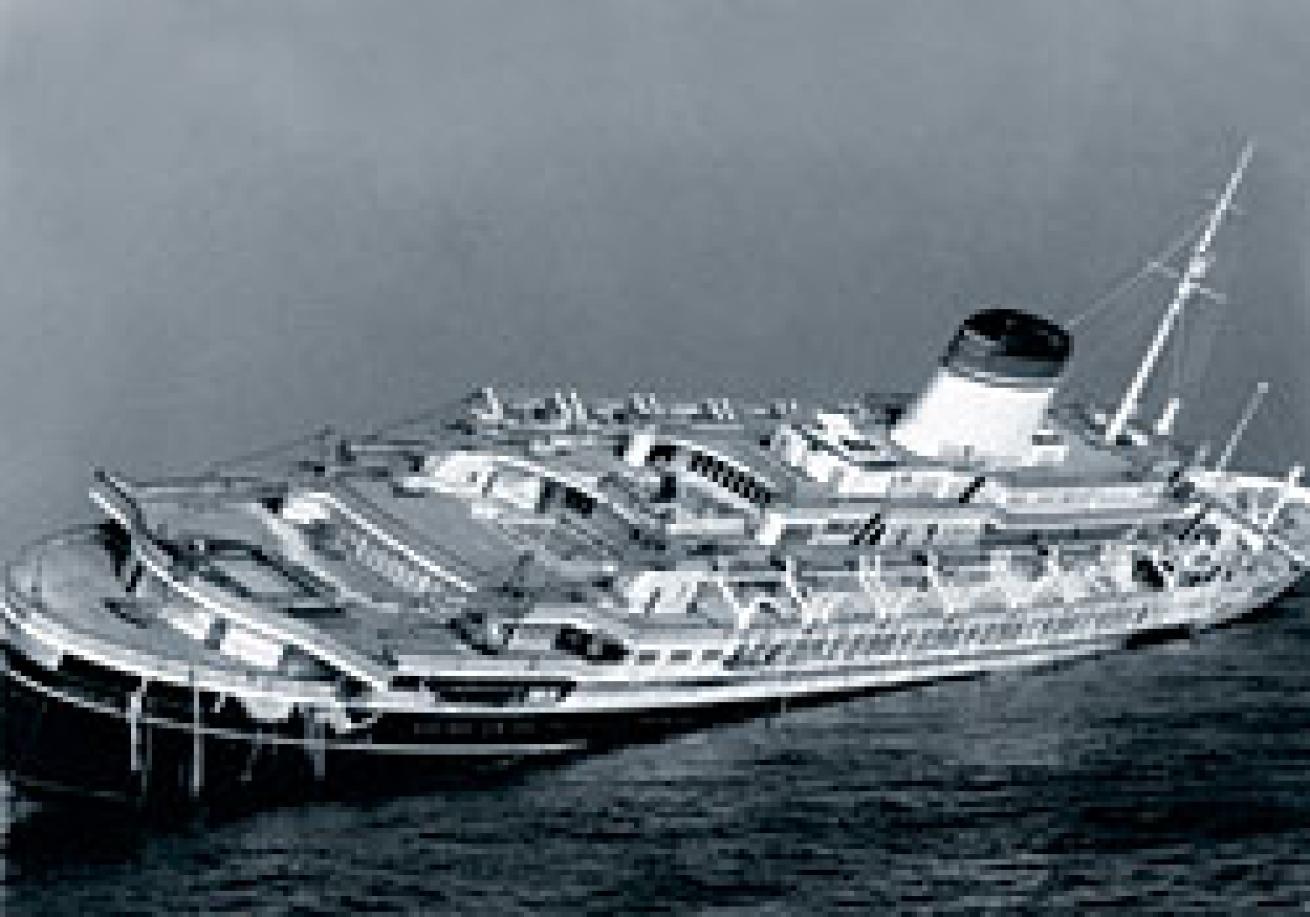
April 2007
REMEMBERING THE DORIA
Nothing Quite Like the Doria
By Bob Sterner
This summer, as they have for nearly every season over the past five decades, a new generation of men and women will brave rough seas for the 100-mile ride to the wreck of the Andrea Doria. They will test themselves, their gear and their training in the kind of adverse conditions most recreational divers fear-dark, bone-chilling water, unpredictable ocean currents and depths reaching 250 feet. If they are successful, they will proudly add "the Mount Everest of wreck diving" to their logbooks. And if they aren't, they may join the roster of divers (14 as of early 2007) who have died in the pursuit.
There are deeper wrecks, like the Lusitania at 320 feet, and the Britannic at 395 feet. There are more historic wrecks, like the USS Saratoga sunk during nuclear tests at Bikini Atoll. And there are certainly more inviting wrecks the world over. But there is no wreck that captures the imagination quite like the Doria.
The dive that once defined deep ocean wreck diving-and inspired men and women to rewrite the rules of the sport so they could safely explore her-will mark the start of her 51st year in the bottom of the Atlantic this summer. Now in a state of accelerating collapse, the Doria's glory days may be over, but divers still come to challenge themselves on a shipwreck that was a legend even before she sank.
The whole world knew of the Andrea Doria, flagship of the Italia Line, long before the 697-foot passenger liner made her maiden voyage in 1953. In the aftermath of World War II, Italy was reclaiming its reputation as the world's nexus of culture and beauty, and the Doria, named for a 16th-century Italian admiral who figured out how to sail ships against the wind, lacked no refinement. It took a full year to fill the interior with the works of Italy's leading artists, and the ship boasted four different sets of ornate china, crystal and silverware-one for each of her three passenger classes and one for the crew. Media around the world tracked the construction and launch of the vessel almost like paparazzi track Jennifer Lopez today.
The Doria's demise three years later also made global headlines. In pea-soup fog, the Doria and the Stockholm, another passenger liner outbound from New York, collided south of Nantucket, Mass. Half of the Doria's lifeboats were rendered useless in the crash, but passengers were blessed with an 11-hour sinking and the biggest rescue effort in maritime history. The 51 who perished — 46 on the Doria and five on the Stockholm — died in the collision. In all, 1,660 passengers and crew were rescued before the ship sank on the morning of July, 26, 1956, ultimately coming to rest on her starboard side.
The following day, New York department store heir Peter Gimbel and Joseph Fox became the first people to dive the Doria. Gimbel photographed the wreck for Life magazine and later led commercial salvage missions to retrieve her safe and other valuables. But it was Michael de Camp, the father of Northeast wreck diving, who led the way for purely recreational divers. In 1966 he rounded up a dozen friends who chipped in $50 a head to get to the Doria aboard a chartered fishing boat.
"We got to the wreck at sunset, so the first dive on it was a night dive," de Camp recalls. "Going down the line, I kept going deeper and deeper and thought I probably wasn't going to come back up. But then the wreck appeared in our lights. It was beautiful. Anemones were starting to grow on its hull and fish were everywhere. We stayed about 15 minutes and then headed up." Gear in those days consisted of steel 72-cubic-foot tanks, over-pressurized and yoked together for maximum volume. There were no depth gauges or tank pressure gauges then, and bottom times were tracked by sealing a watch in a plastic case. If it flooded, the increasingly harder draw on your unbalanced double-hose regulator gave a physical cue it was time to head toward the surface. Extreme narcosis was a given on every dive, and for thermal protection in 48-degree water, divers shivered in quarter-inch wetsuits. In a January 1969 cover story in Skin Diver magazine, cinematographer Al Giddings was the first to compare the Doria to Mount Everest. He was referring to the difficulty of filming the wreck-the dense silt particles blowing everywhere reminded him of a Himalayan peak in a howling snowstorm — but the description stuck because it also summed up the extreme physical challenge of diving the wreck.
The heyday of Doria diving began in the 1980s. Improved gear made it possible for divers to stay on the wreck longer, and there was the new challenge of penetrating the wreck's interior. During their 1981 expedition, Gimbel and his crew cut an opening into the first-class section of the ship and now recreational divers were using it to prowl below decks and bring back souvenirs. Abundant and portable, the ship's ornate china and silver were favorites and soon became badges of wreck-diving honor. There were even regular charters to the wreck, but they were by invitation only as the Doria was still very much outside the bounds of normal recreational diving. In response to the wreck's rising death toll, the men and women who explored the wreck scoured deck plans to make their penetrations safer. They embraced advances in gear and experimented with any technique that could lengthen their bottom times. "Doria diving became more cerebral," explains Dan Crowell, former captain of the Seeker, a popular ride to the wreck.
Wreck explorer John Chatterton credits the willingness of Doria divers to take risks and experiment with decompression procedures, nitrox and mixed gases, with bringing technical diving into the mainstream. Until the 1990s, "there were no standards," Chatterton says. "We'd bastardize the Navy tables and compute our own decompression stops. We weren't promoting anything; we just wanted to explore. The cooler heads in the dive industry knew where we were going, and did a great service by developing standards and training. All of this came about from the Andrea Doria."
Diving the Doria is still a physical challenge, but divers no longer have to gut out extreme narcosis or push the limits of oxygen toxicity on the wreck. Today, mixed gas diving on either open-circuit scuba or rebreathers is both the norm and a necessity as the wreck has begun to flatten out on the sand. "It's collapsed quite a bit," Crowell says. "Divers used to look over deck plans to see where they wanted to go, and getting there was almost like following the blueprint. Now, it's like someone took all of those prints and crinkled them up."
Photographer Brad Sheard was amazed at the wreck's disintegration when he visited it last summer for the first time in 10 years. "What we dove on was almost a pile of rubble it was so flat. It was disappointing. One of the most alluring things about the Doria was it being this big intact ocean liner lying on its side. You could swim along the wreck and go past the three swimming pools one after another with all of their diving boards still in place. Now there are staircases that had been inside, out lying in the sand. You can't swim down through the wreck to the first-class bar and look for china. For me, the magic is gone." Taking souvenirs has always been a big draw of the Doria. China, crystal, silverware, silver trays, drink markers, shuffleboard pucks and other trinkets all emblazoned with the Italia Line logo are among the cherished mementos of elite wreck divers. Although the interior cubbyholes where these items were stored may now be buried under rubble, there are still artifacts to be found, and the collapse of the wreck is adding urgency to recovering them.
John Moyer obtained salvage rights to the Doria in 1992 just before wresting two 1,000-pound ceramic panels from the ship's Winter Garden Lounge. The six- by five-foot artworks were created by Guido Gambone, a Picasso contemporary, and along with a bronze statue of Admiral Doria, are the centerpiece of Moyer's traveling museum show on the wreck. When he returned two years later, the lounge had collapsed to the seafloor.
Despite his stake, Moyer encourages divers to take small artifacts like china and silverware if they find them. "The thrill that is the Doria is that it is an important part of maritime history," he says. "The wreck is falling apart, like all wrecks do. It's important that things get recovered, properly restored and displayed in public to keep alive the legend of the Andrea Doria."
The Air of Everest
By John Chatterton
It was called "the Mount Everest of wreck diving," and in many ways it really was. Before rebreathers and before trimix, air-breathing wreck divers were testing themselves and their equipment on the wreck of the Andrea Doria. In retrospect, I consider myself lucky to have been there in the 1980s. I was in the right place at the right time.
Long before I made my way to the wreck, it had been explored by virtually all of the sport's wreck-diving legends like Peter Gimbel, John Dudas, George Hoffman, Mike de Camp and Bill Nagle, yet they barely scratched the surface of the wreck's potential.
Nagle was the captain of the dive boat, Seeker, my usual ride. He was an experienced Doria diver and my wreck-diving mentor. Before I made my first dive to the wreck, Bill warned me that the Doria was very dangerous. I clearly understood that any wreck in 250 feet of water was indeed a dangerous place for a diver, but that was not what he meant. "The Doria is dangerous because it is so highly addictive," he said. "You'll see. You'll have to keep coming back."
I thought Bill was crazy. I knew how much preparation, dedication and money it took just to get there. I was not going to make 100 dives on the Doria. I was going on a single trip, it was going to be the highlight of my diving career, and then I was moving on, or so I thought. Ultimately, Bill was right. I would make more than 150 Doria dives before the new millennium.
The Doria lies on her starboard side in about 250 feet of water. Back in the 1980s the port side was only about 180 feet deep. On the right day, any open-water diver could swim down and touch the Doria. The problem is that you can't tell from the boat if it is the right day. Oftentimes the ocean surface will be completely still, but current can be roaring on the wreck. Visibility can be 100-plus feet, but it is more likely to be 10 to 20 feet. One thing is for sure: It's always cold, roughly 38 to 48 degrees.
Until computers came along, we had to use the U.S. Navy dive tables. Unfortunately, there were no repetitive tables for air dives over 190 feet. We were not going to stay above 190, or sacrifice our repetitive dives. We overcame this obstacle by interpolating the Navy tables in a way I should probably not describe. It was not exactly what we learned in open-water training.
In the 1980s, deep diving was not acceptable to the mainstream. It was outlaw diving and we were bad boys (and girls). Of those who crossed the 130-foot redline, there were divers who were content simply to make it to the wreck and satisfied to touch the exterior. But what made the Doria the Doria was found inside. Its uniqueness was defined by the almost limitless penetrations it offered. Completely unexplored areas of the wreck awaited those willing to enter. This is what made the Doria different from all the other wrecks of the day. It gave you plenty of rope to hang yourself.
Like most of my peers, I became bolder with every dive. Eventually, I could swim solo down to the wreck, drop into the promenade, swim down to the double doors, enter into the wreck on the promenade deck, swim aft to a stairwell, travel in the stairway down two decks to the foyer deck, come out in the second-class foyer, cross into the second-class dining room, swim aft to the bulkhead at the revolving door, drop down to 230 feet, and enter the corridor into the second-class kitchen. There I would find a cabinet and collect a few souvenirs of glassware. Alone, on air, without a penetration line, this was incredibly aggressive diving.
Why break all the rules of diving to risk dying lost and alone? For me, I wanted to go where no diver had ever been. It was about challenging myself and answering the question, "Could I do it?" Could I figure out a way to go beyond where I had been and get back? Maybe others had different reasons. Regardless, it was adventurous diving and there were numerous injuries and fatalities to prove it. Looking back on the way we dove back then should make any modern day certified diver cringe.
Unfortunately, the days of vast penetrations on the Andrea Doria are gone. The wreck is collapsing and is barely recognizable for what she once was. While the Doria has been in decline, diving has changed dramatically, too. Today we know more about both diving and education, and we have better tools. We dive deeper, longer, and we are much better equipped to manage the inherent risks of diving deep shipwrecks. However, for a short time, the Andrea Doria really was the Mount Everest of wreck diving.
The Greenhorn
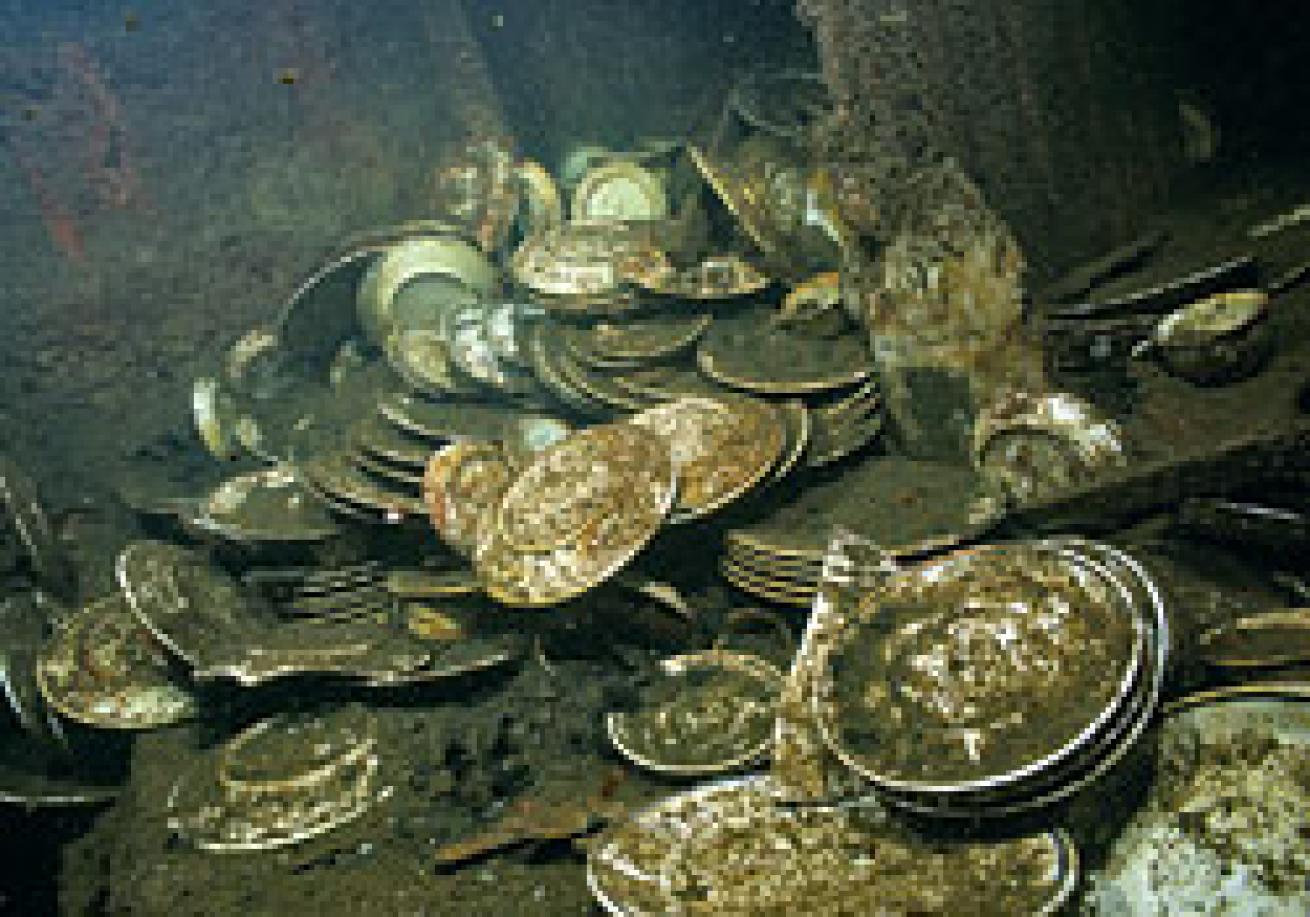
By Richie Kohler
In 1985, I received Capt. Steve Bielenda's call inviting me on my first Andrea Doria trip. How could I say no? The only way to get on a Doria expedition in those days was to be personally invited. I thanked Steve for the opportunity, but knew the person responsible was Pete Guglieri, the unofficial leader (or "Emperor for Life") of the Atlantic Wreck Divers. I was the youngest member of the club, and Pete had taken the "greenhorn" under his wing. Bielenda's invitation meant more than a coveted spot on the charter. It meant Pete had told him I was ready-that I had proved myself worthy to dive the Doria.
When the Wahoo headed out Fire Island inlet for the all-night journey to the wreck, the enormity of the dive really sunk in and the pre-dive jitters in my head turned to a palpable fear. I was painfully aware that men had died inside the wreck. Sleep didn't come easy that night. The next morning when it was time to dive, I could barely muster enough spit to clean my mask.
The current tugged at me the whole way down the anchor line, and I was almost on top of the wreck before dark shapes came into view, macabre shadows dancing in the stabbing lights of the divers head of me. Once my eyes adjusted, I saw the grapple was secured to a stanchion on the promenade deck. All the upper decks were to my right, like layers of a cake, but the view of the hull to my left was flat and featureless with the occasional anemone or starfish. It looked more like the seafloor than the side of a ship. Only by looking carefully could you see the outlines of closed portholes, aligned in neat rows. I smiled as my hand touched the hull. I made it!
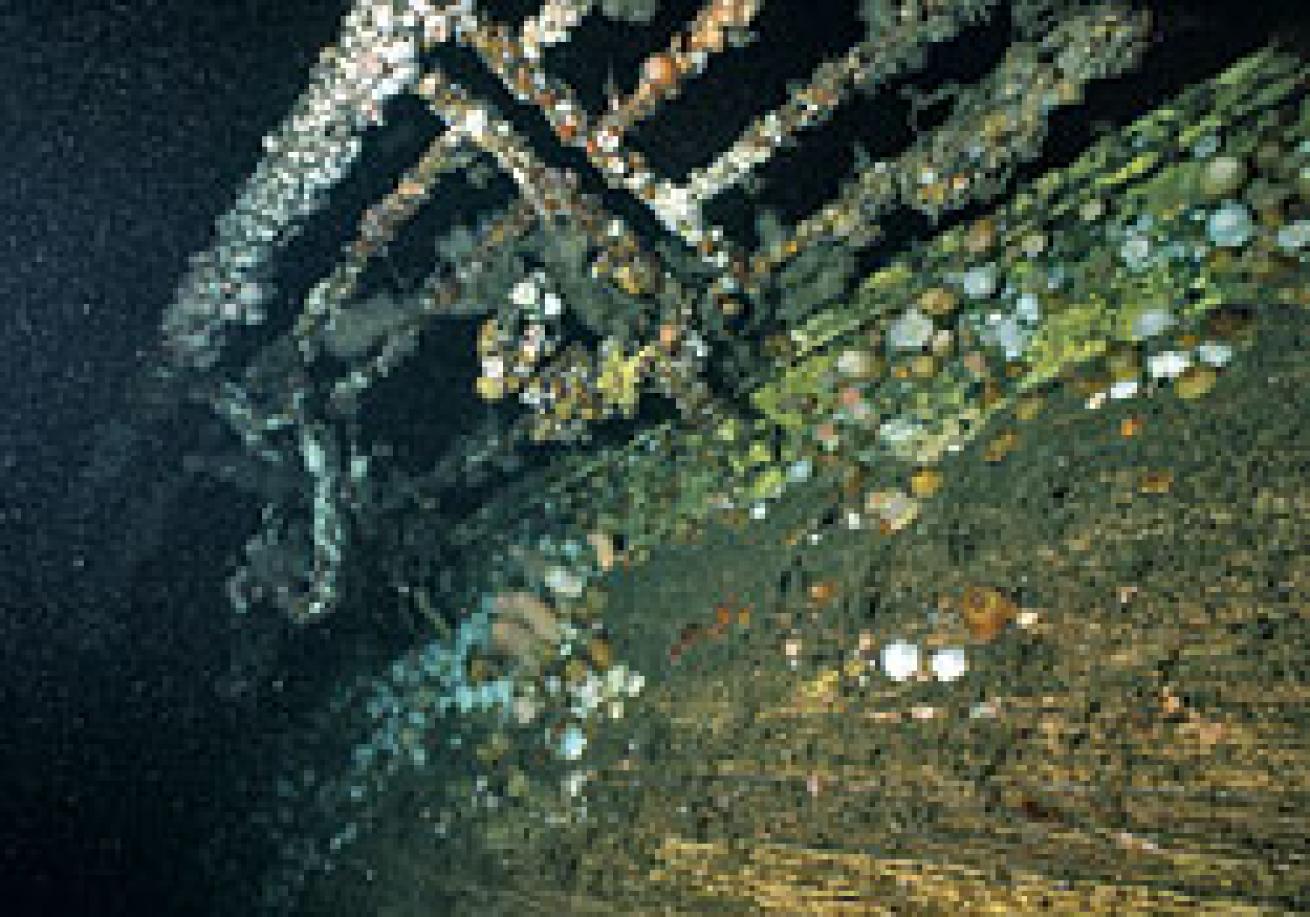
On my second dive, Pete would take me inside the wreck to help him look for pieces of the ship's famous china, but first he detailed the dive plan step by step. Dropping into Gimbel's Hole we'd face aft, staying close to the floor (now the right wall) and watch out for cables hanging down on the left. When we got to the china cabinets, we'd turn around and face the exit. My left hand was to stay on the wall and my right hand on his harness, and under no circumstance was I to let go of either one. Once he started digging for china inside the wreck, the visibility would be gone. My hand on the wall would prevent us getting turned around and trapped inside.
My pulse quickened as Pete's dive plan played out in real time. Continuing slowly into the wreck, side by side, we soon found a silt pile known to hold china. The easy pickings were gone, so you had to root through the mud and junk to find anything. Pete turned around, then I followed suit before settling down to work. Hooking my right hand under his harness, I gave a tug to say, "I've got you." Soon, swirling mud and silt filled the water.
Fighting narcosis, I focused on keeping one hand on Pete and the other on the wall. Soon the rhythmic sound of our exhaust bubbles was interrupted by the unmistakable clink of china being stuffed into the bag and of Pete giggling through his regulator. Hearing him laugh put my rising anxiety at ease. My light was switched on and secured to my chest harness, but almost useless in the swirling maelstrom of silt. In the few inches of visibility below me, my light reflected off something. I dropped closer and could see an intact plate bearing the Italia signature on the rim. Without thinking about it, I let go of the wall and grabbed it.
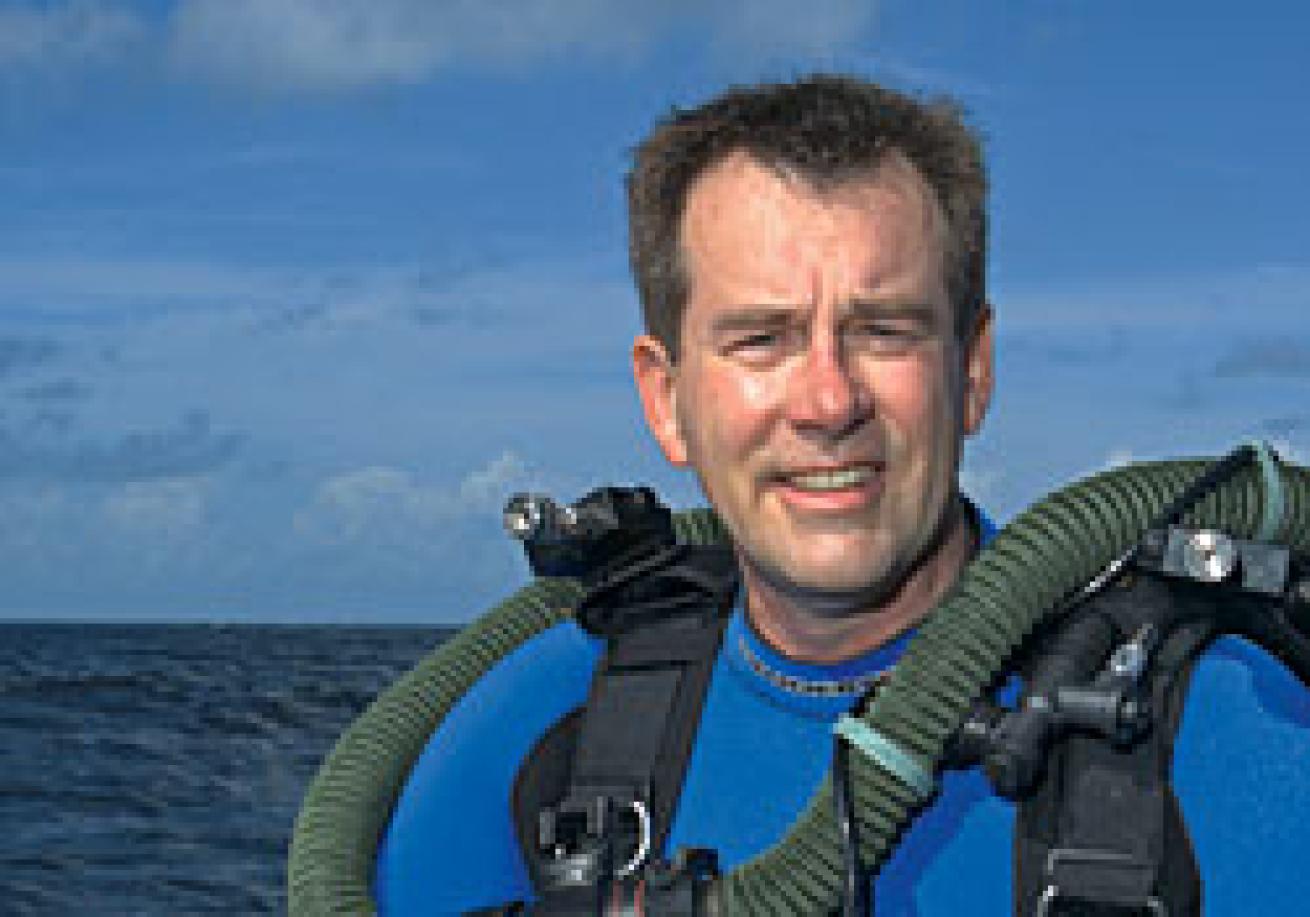
I tugged hard on Pete and waved the dish where his head should be in the mud-stained water. I thought he would take it and put it in the bag, but instead I felt him tense up and stop cold. Through his regulator he yelled, "The wall! The wall!" and the urgency in his voice jarred me. Alarmed, I dropped the dish like a hot coal and swung my hand back onto the wall. Pete's face suddenly materialized out of the dark silt, right in front of mine. His eyes were wide inside his mask. Grabbing me hard by the arm, he said, "Let's get out of here!" He counted on me and I screwed it up, and now we were aborting the dive.
During our ascent, the few seconds we made eye contact spoke volumes. He wasn't angry, but disappointed. Aboard the Wahoo, other divers congratulated me on my first dive inside and took pictures with the dishes Pete had bagged. Pete didn't say a word about what happened, but after dinner he pulled me aside on the back of the boat and asked, "What were you thinking, man? Don't you realize what could've happened?" I didn't answer right away, but held his gaze. "Yeah, I lost my focus down there and could've gotten us both killed for a dish. It won't happen again," I replied.
Pete turned, stared out at the darkening sky for a moment and without looking back said, "You learned your lesson and I know you'll do better tomorrow. You just went to school."
